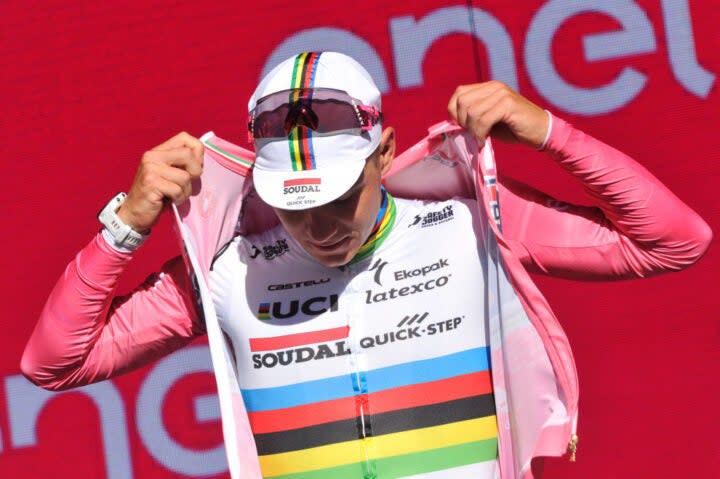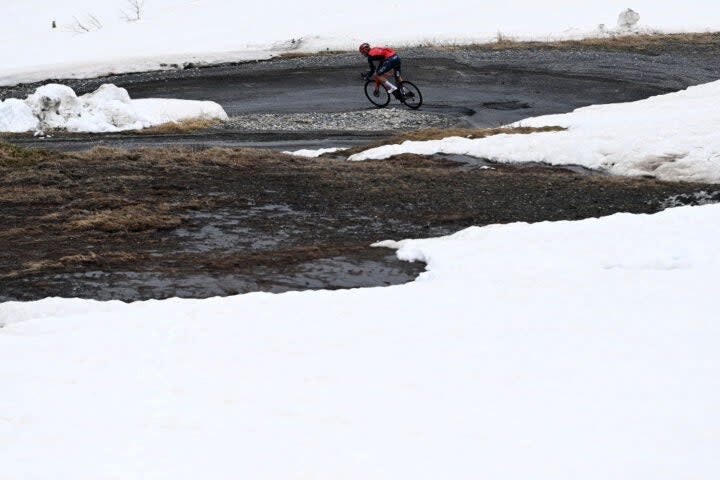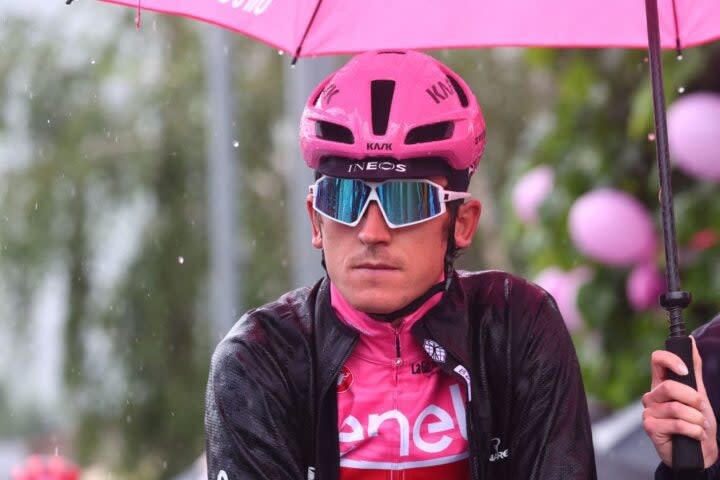Giro d’Italia: Most attritional edition in memory becomes race of waiting and surviving
This article originally appeared on Velo News
The Giro d’Italia’s grande casino span some tough numbers the past two weeks.
COVID-19, crashes, woeful weather, and waves of sickness have made this Giro one of the most attritional in decades and boiled the race for pink into a waiting game of survival.
After the exit of Remco Evenepoel, Tao Geoghegan Hart, and home hero Filippo Ganna, the Giro saw another jab at its flank Friday.
Touted one of the race’s centerpiece tappone, Friday’s high mountain triple-header into Switzerland was truncated by weather and - in the case of the GC group - decaffeinated by headwinds.
Also read:
The hulking shadow of an extra-hard final week of climbing and a delicately poised top-three produced the second classification no-show of the race Friday.
The stage 13 stalemate mirrored the GC slog up the Appenine icon that is the Gran Sasso one week prior in a Giro still waiting for a GC firework.
"The way the wind was at the end it made it hard for attacks," pink jersey Geraint Thomas said at the finish Friday.
"I was waiting for some big attacks, but I think Primoz [Roglic] was probably happy to leave me in the jersey for a few more days and let us control the race and bide his time for the final week."
Highest dropout rate in almost 30 years

Giro d’Italia boss Mauro Vegni is crossing every digit that his race makes it through the next week unscathed, and that drama comes from the racing rather than the numbers of DNFs and days of dark weather.
“It is a case of force majeure. I have to get the Giro to Rome, that is the most important thing,” Vegni told Sporza of his race’s coronavirus curse. “This bad weather absolutely doesn’t help, and that worries me more at the moment.”
Only three of the peloton’s rain-soaked squads made it to the third weekend of the race with all eight riders still on the bus.
Just 135 riders started the shortened stage Friday, over 40 fewer than those that rolled down the start ramp two weeks ago.
Per Spanish outlet AS, that’s the most dropouts at this stage of the race in almost 30 years, making this the most attritional Giro in decades.
The 10-year dropout cumulative in #Giro d’Italia versus this year.https://t.co/7JUmvmkQOC pic.twitter.com/WqeC37rpHO
-- ProCyclingStats.com (@ProCyclingStats) May 18, 2023
As a comparison, last year’s Giro saw 27 dropouts, while 41 starters failed to finish in 2021. The October COVID-edition of 2020 tops the recent casualty list at 133 finishers of 176.
“We've seen so many guys going home with sickness, so if we want to get to Rome with at least 50 guys, it's a good decision,” Thomas said of Friday’s stripped-down Swiss stage. “It's still going to be hard racing, so I think it's a decent compromise.”
Ironically, it’s Thomas and Primoz Roglic, two of the peloton’s most disaster-addled stars, that have emerged from the Giro’s grande casino mostly upright and now leading the classification.
Of the top-echelon of pre-race contenders, five-star favorite Evenepoel left with COVID, Geoghegan Hart is in hospital with a smashed hip, Aleksandr Vlasov is out sick, and Jack Haig crashed more times than he can count.
Half of Roglic’s support crew didn’t even make the Abruzzo start after COVID swept through its ranks in a portent of the carnage to come.
Washed out but riding on

The COVID wave that spread its tentacles out of the Tour de Romandie was only the first half of this Giro’s problem as Italy faces its worst late-spring weather in decades.
This weekend’s Imola Grand Prix was canceled due to foul weather and thousands have been displaced after record floods devastated the Emilia Romagna region.
The Giro’s reintroduction earlier this week of strict COVID measures throwing back to the 2020 season seem to have stimied the tide of the virus, but there’s no stopping the weather gods that derailed Vegni’s kingmaker 13th stage Friday.
“The weather conditions experienced during this year’s Giro have been among the most intense. In response, the riders held a vote last night to invoke the extreme weather protocol,” said Adam Hansen, leader of the CPA riders’ union.
“According to the regulations, which outline freezing rain as point 1 and extreme temperatures as point 4 during certain parts of today’s route, the riders agreed to vote.”
Given the adverse weather conditions, especially on the Italian side, the Commission decided to meet the athletes’ requests by applying the Extreme Weather Protocol.
Stage 13 will be shortened with the new km 0 being set at Le Chable, at the bottom of the Croix de Couer. The... pic.twitter.com/6VwMOw8enS
-- Giro d’Italia (@giroditalia) May 19, 2023
Two weeks of cold, wet weather put the peloton on protest Friday as riders called for the stage to be reconfigured.
The grizzly weather through the front-half of the race ramped the corsa rosa‘s attrition rate as sickness and G.I. issues culled riders that escaped the carnage of slick roads and frozen descents.
“It has already been a terrible Giro,” Ineos Grenadiers rider Laurens De Plus told Sporza. “I’m glad the riders used one vote. Everyone crossed the line safely.”
‘Hopefully we still have some mountains left in the Giro’

A breakaway or sprinter stage Saturday will see Thomas, Roglic, Joao Almeida, and the rest of the pink jersey hunters cool their jets ahead of Sunday’s tricky medium mountain stage through Il Lombardia country.
Thomas and the GC stars are convinced the cursed start to this corsa rosa won’t tint the action in the eight stages to come.
"Weather-wise, it's been the worst, but it's kind of the norm in bike racing at grand tours to have huge crashes and GC guys crashing out," Thomas said earlier this week.
"You get a list of favorites at the start, and it's very rare that they all finish the race, let alone finish in the top 10.”
Forecasts call for mixed conditions over the Alps and Dolomites in the coming days. The peloton seems likely to see cool, damp weather in the high mountains but none of the washouts that wiped the race so far.
Riders that favor the long, hard tappone that make the Giro what it is are pinning their hopes on a third week free of stages decapitated by bad weather or derailed by any other disaster.
“Hopefully we still have some mountains left in the Giro,” GC threat Hugh Carthy said Friday.
“We're tired, but the climbers and GC riders, there's been stress with crashes and weather, but there's not been many opportunities to test our legs, so I think most GC riders will be fresh and motivated. I don't think what's happened so far will change too much.”
📊❌With 4 more dropouts after s12 (40), 🇮🇹Giro’23 is on it’s way to become the GT with most dropouts since 2010.
➡️🏁Share DNF after stage 12:
23% | 🇮🇹Giro’23
20% | 🇪🇸Vuelta’22
19% | 🇮🇹Giro’20
16% | 🇫🇷Tour’21
16% | 🇫🇷Tour’12
15% | 🇮🇹Giro’10
14% | 🇪🇸Vuelta’20
14% | 🇪🇸Vuelta’16 pic.twitter.com/NTP9b1nafQ-- Cycling Statistics 📊 (@StatsOnCycling) May 18, 2023
Some critics call for a full upheaval of the Giro’s model to prevent some of the carnage that scarred the 2023 edition.
Suggestions have been made the race could be swapped in the calendar with the Vuelta a Espana to put the peloton into the mid-August Italian sun, while others want to put an end to the endless 200km stages and 2,000m climbs.
But the old-school brutality of the Giro is what makes the race what it is.
It’s just the perfect storm of conditions has made the so-called “hardest race in the most beautiful place” that bit harder and a bit less pretty this time around.
For exclusive access to all of our fitness, gear, adventure, and travel stories, plus discounts on trips, events, and gear, sign up for Outside+ today.

